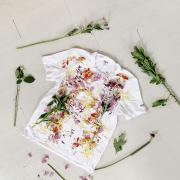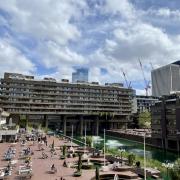
With the recent protests held by school children around the country, the subject of our environment is once again on everyone’s lips. An area whose environmental impact remains overlooked, however, is the fashion industry.
Until very recently I didn’t think much about the origins of the items I was buying, particularly when it came to clothes. Like most people I looked for what was cheap and aesthetic, even if that came at the cost of the materials and the labour. It wasn’t until recently, when I attended an assembly led by a school friend of mine, that I realised just how unsustainable the fashion industry currently is.
The fast-fashion industry of today is a relatively new concept, born from competition between brands fuelling excessive consumer demand. It’s worth £32 billion (as of September 2017) and employs over 890,000 people.
However, this all comes at a cost. One pair of jeans requires about 15,500 litres of water to be produced - around 21 years of drinking water for one person. The chemicals used in inorganic cotton farming are causing eutrophication and desertification. Worst of all, the synthetic fibres now found in most clothing are getting into the marine ecosystem.
These ‘microfibres’ are shaken out of clothes during washing cycles, and end up in oceans as they’re too small to be trapped in treatment plants. The fibres pick up toxins easily due to their composition and are mistaken for food by plankton. As a result the fibres (and toxins) accumulate up the food chain, eventually being ingested by us.
And 237,400 kilos of these microfibres are produced in the UK annually. That’s the mass of 150 average-sized cars.
The need for low prices to attract customers has also led to the large-scale abuse of workers at all stages of production. The International Labour Organisation estimates that 170 million children around the world are engaged in labour, with many making textiles and garments. More than 540 female workers came forward to The Guardian last year detailing the gender-based violence they experienced working in garment factories supplying high-street brands such as H&M and GAP. Even in the UK, reports came to light earlier this year of garment-makers being paid as little as £3.50 an hour.
Even though many brands now have strong, clear ethical policies (it’s worth mentioning that H&M and GAP immediately launched investigations in lieu of the second example), cases such as these highlight how difficult it can be for a large company to trace its supply chain. At this scale practices such as subcontracting are common, so large companies are rarely able to track down every one of their suppliers.
This may all seem scary, but thankfully there are simple steps you can take to ensure that your fashion choices become more sustainable and ethical.
1) Buy second-hand
A good consequence of fast fashion has been the surge in popularity of purchasing clothes second-hand, whether that be by thrifting or through sites such as Gumtree and Depop. Not only can this be considerably cheaper but it also allows clothes to be reused, saving on vital resources. Similarly, buying clothes made from recycled materials is much better than requiring those materials fresh, especially when the material isn’t biodegradable.
2) Reduce your microfibre output
Every item of clothing sheds microfibres to some degree, although natural fibres such as cotton aren’t considered to be so much of a hazard since they’re biodegradable. Hence, one way to avoid microfibres would be to only buy clothes made from natural materials such as cotton, flax, hemp, linen, wool, cashmere, mohair and silk.
But in practicality, it’s quite rare to come across clothing that’s completely free of man-made materials. While a shirt may be labelled as ‘cotton’, for example, it’s most likely a cotton-polyester mix. And there isn’t enough evidence yet to prove that semi-synthetic fibres such as rayon and viscose aren’t problematic either. In the words of Claire O’Loughlin, a pioneering researcher on microfibre pollution, “others may be looking at the problem wishing we could just get rid of synthetic fibre, alas that’s not going to happen”. At least not soon.
So for now the interim solution is to reduce the number of microfibres leaving our homes. Using a front-loading washing machine, a lower temperature and a lower spin speed all help to reduce the number of microfibres shaken out of clothing during a wash. As well as this there are now laundry bags and laundry balls available, which help to collect microfibres when placed in with your washing. Although they aren’t perfect, collecting some is much better than not collecting any at all.
3) Research your brands
Sites such as goodonyou.eco are incredibly useful. They provide in-depth analysis of brands’ environmental impact and labour policies, as well as their use of animal products such as leather. They also offer ideas for sustainable alternatives to many cult-favourite brands and products.
Some of my favourite sustainable brands that I’ve found so far include;
Dorsu - this Australian company makes their clothes from discarded fabric remnants, and their employees are paid a living wage under permanent contracts. It primarily sells more basic items at the moment but has a wide range to choose from. They are rated ‘great’ by Good On You, the highest score that a company can receive.
Dolores Haze - named after the main character of the novel ‘Lolita’, the company manufactures exclusively in New York City and places emphasis on the use of locally-sourced, recycled materials. The products are slightly more expensive but I love their style, which is similar to that of urban outfitters. It's rated ‘good’ by Good On You.
Etsy Shops - surprisingly, another great place I’ve found for sustainable clothing is Etsy. The online marketplace allows small businesses to sell their products online, and this includes many businesses selling handmade clothing. A simple search for “sustainable fashion” brings up a plethora of sustainable UK-based small businesses.
Some better-known brands also have sustainable ranges, such as H&M Conscious and Monki. The clothing in these ranges is made at least partially from recycled materials.
I know this has been a long article, but if you’ve reached the end I hope this has inspired you. In a world where fast fashion is almost synonymous with our lives and our society, it can be difficult to step back from it all, but only by demanding change as consumers will we begin to see a shift to more sustainable practices in fashion. At the end of the day, the most important thing is just to know exactly what you’re buying and to be aware of the impact.



























